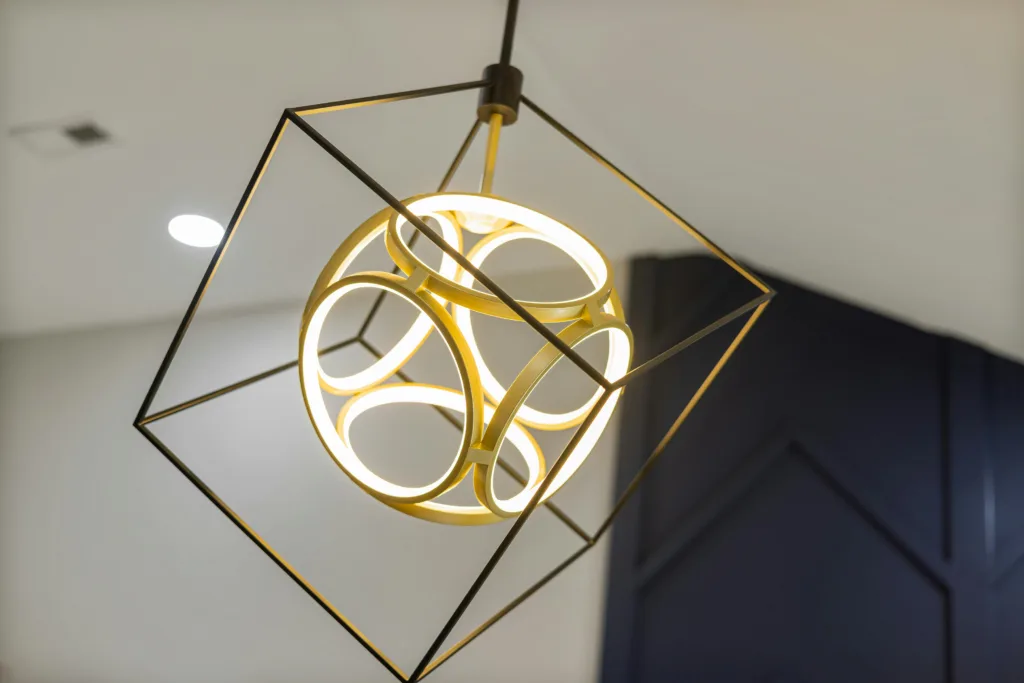New! DIY Project Planner. Plan smarter, skip the spreadsheets. Start Your Free Trial Today →

Want to swap out an old ceiling light or update a dated fixture? This guide walks you through the full process — safely, confidently, and without hiring an electrician.
Tools
Materials
Just a heads up: Some of the links below are affiliate links, which means we may earn a small commission if you buy through them (at no extra cost to you). We only recommend gear we trust — thanks for your support!
Go to your home’s electrical panel and switch off the breaker that controls the light you’re replacing.
Not sure which breaker it is?
Flip the switch controlling that light before heading to the panel. Then test by turning it back on. Label it for future reference.
⚠️ Important: Once the breaker is off, use a non-contact voltage tester to check the wires in the ceiling box. Even if the light is off, the wires could still be live — don’t skip this step.
Here’s the tester we recommend → Klein Tools Non-Contact Voltage Tester
Take off the lightbulbs, then unscrew the fixture base or canopy from the ceiling.
Tip: Keep one hand supporting the fixture as you disconnect the wires.
Never let it hang by the wiring.
Check that the ceiling box is securely attached and not cracked.
Bonus Tip: For heavier fixtures (like chandeliers), the box should be rated to support more weight. Look for a “ceiling fan–rated” box if in doubt.
Most fixtures come with a metal bracket that connects to your ceiling box.
Grounding screw?
If your bracket has a small green screw, that’s where you’ll attach the ground wire in the next step.
Need a universal bracket kit? Try this one → 2 Pack Universal Light Fixture Mounting Bracket
Match the wires from your ceiling to the wires on the new fixture:
Not confident?
Take a quick photo of the old wiring before you disconnect anything. It’s your cheat sheet.
⚠️ Mistake to avoid:
Don’t leave bare copper exposed outside the wire nut. If you can see wire, trim and try again.
Need wire strippers? Check out this set → Klein Tools 11055 Wire Cutter and Stripper, Made in USA
Once the wires are connected and secure:
It should sit flush against the ceiling. If it’s off-center or wobbles, check that the bracket is aligned and fully tightened.
Screw in bulbs that match the fixture’s wattage rating.
✅ Success:
If the light works, you’re done. If not, double-check that all connections are tight and properly matched.
Swapping a light fixture is just the beginning. Browse our DIY guide library for more ways to brighten up your home—safely, confidently, and affordably.
Pro Tips for a Smooth Install
- Use a headlamp or clamp light while working — makes hands-free wiring easier in dim spots.
- Mark your wires with tape before disconnecting if the colors aren’t obvious.
- Have a helper nearby if your fixture is heavy or bulky. One person supports while the other wires.
- Double-check wattage compatibility — some LED fixtures don’t play nice with older dimmer switches.
Common Mistakes to Avoid
❌ Reusing old wire nuts — always use new ones with every fixture to ensure a secure, reliable connection.
❌ Forgetting to shut off the breaker — use a voltage tester to be 100% safe.
❌ Leaving bare wire exposed outside the wire nut — always trim if needed.
❌ Mounting the fixture before checking wire connections — test everything first.
Swap that old fixture safely with these must-have tools and materials:
Don’t guess. Grab the go-to tools we recommend for any home project. Reliable, beginner-safe, and worth every penny.
Join our free DIY email list and get weekly tips, tools, and guides to tackle your next home project like a pro. No spam, just real help.